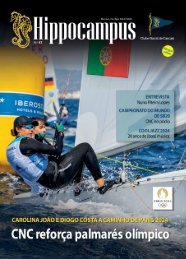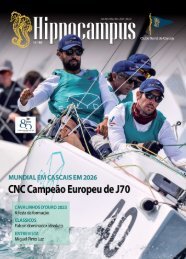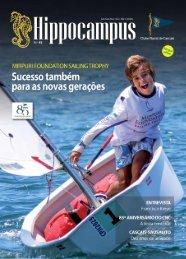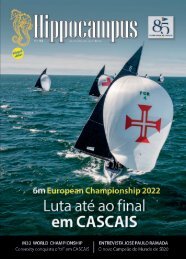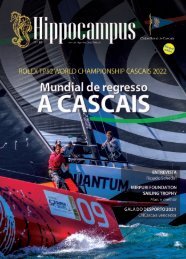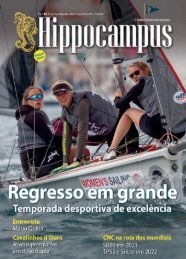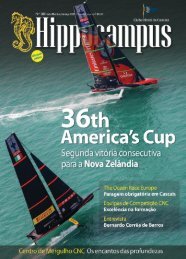You also want an ePaper? Increase the reach of your titles
YUMPU automatically turns print PDFs into web optimized ePapers that Google loves.
the CNC, position to which he was appointed
last June. A role that he will necessarily perform
with the commitment that is (re)known to him,
and even in a different way from what has been
customary until now, since, from now on, the
Commodore will have a seat on the Executive
Committee, in order to increase his connection,
and participation, in the day-to-day life of the
institution. All this is more than enough reason
for a fundamental interview with someone who,
like few others, knows the reality of CNC,
and will not fail to share the vision of what is
intended to be its future growth.
FROM LISBON TO CASCAIS
A member of Clube Naval de Cascais since
1972, José Sotto Mayor Matoso has no ancestral
connection either to the club or to Cascais,
although sailing, the region and the CNC
have been in his life since very early. “I don’t
have family parchments of CNC members
because my family was from Lisbon, having
moved to Cascais in the 1960s. On the
other hand, as my father was a naval officer,
he was a member of CNOCA, the Clube
Náutico de Oficiais e Cadetes da Armada,
and not a member of a traditional club - if
he had been, then he would probably have
been a member either of the CNC or the
Associação Naval de Lisboa”.
But the twists and turns of life eventually
made José Sotto Mayor Matoso a true Cascalense
(a native of Cascais), and a true man of
the sea: “I moved definitively to Cascais in
1963, when I was ten years old, and before
that I was sailing with my father, who had
a 33 foot yacht. I remember that my first
nautical expedition was to go with him
from the Belém dock to Praia da Rocha, I
would be about seven years old, and it was
something I will never forget. I remember
clearly how I was hanging on to the biscuit
cans (which were still tin cans, at that time,
squared...). Anyway, it was always going
down, with the north wind, in a heavy and
big boat, and the travel was quite good.
These are my first ideas of being in the
water. In fact, I formally learned how to
swim still in Lisbon, in an institution that,
fortunately, still exists, the Clube Nacional
de Natação (National Swimming Club),
in the Rato area, in the icy water of open-
-air swimming pools. But, in fact, where I
learned to swim was around the ‘Senhor
da Piedade’, which was the name of my
father’s boat, with the skipper, who was
Patrão Lopes, his former subordinate in
naval aviation, in Belém - a man of the
sea, who spent years and years as Captain
of the boat. And I, with a cable tied at my
waist, and he strolling me around the boat.
I remember it as if it were today...”.
Then came the passion for sailing: “Around
the age of 12 or 13 I started sailing. Still in
Belém, because in Cascais there were still no
such protections, and the nautical activity
was basically during the summer months.
Either yachts, Snipe or Dragons, with the
vessels that were here, what existed was a
small sailing school. So I started sailing in
Lisbon, and in a very modern way: I don’t
remember the name, but who taught me
to sail was an instructor, a girl, who was
also a sailor - and at that time the women
sailing could be counted on the fingers
of one hand. As I had some friends and
cousins who were from Lisbon and were
sailing there, I took the train in Cascais
and went to Belém station to sail”.
Naturally, the conditions at that time were
not the same as they are today, particularly
with regard to the boats available for training:
“I managed to get a Snipe, with which I
started sailing, from the Naval Brigade.
The Naval Brigade was the nautical section
of the Portuguese Legion, in continuation
of Mocidade Portuguesa. The programme
was to sail in the Tagus, to go out, to learn.
Then, I inherited from my father a boat that
we later offered to the club, and that was
one of the first sailing school boats able to
take more than two or three people, still
made of wood.
At that time, the most beautiful expedition
was to go to Cova do Vapor. On
days of good weather, normally there was
no wind, returning was always a trouble,
we would arrive at ten or eleven at night,
and my father worried to see if we had all
died, and we would were there with three
or four boats...
I then started to sail Finn, but I was already
about 17 years old. It was a boat that
I experienced at the end of my training in
Snipe, and for which I became very interested
because, in 1971, the Gold Cup was
organised in Cascais, the most participated
class of all. We had 160 or 170 boats here,
the old South Pier was used, built a year
before, in good part also thinking about
that enormous race.
Clube Naval de CASCAIS 27




